Overview
The Sound Quality Analyzer (SQA) conducts psychoacoustic sound quality analysis on standard audio WAV format files. SQA is a low cost, easy to learn to use, sound quality analysis tool for use with product and equipment noise emission recordings.
SQA processes standard audio WAV format files and provides several methods of establishing level calibration.
- Recordings made with our Trident data acquisition software have embedded normalization and will automatically be calibrated with retrieved into SQA
- Recordings with known A-weighted sound pressure levels can calibrated based on the known level
- Recordings of a calibration signal with the settings as the recording to be analyzed can be used to establish level calibration
Sound Quality Analyzer conducts the following analysis
- Weighted Sound Levels Overall (A, B, C, Linear)
- Weighted Sound Levels vs Time (A, B, C, Linear)
- 1/N Octave Band Analysis (1/1, 1/3, 1/6, 1/12, 1/24)
- FFT Analysis (Magnitude, Power Spectrum, Power Spectral Density) with user selectable resolution
- Short Time Fourier Transfer (STFT) Analysis
- Recordings of a calibration signal with the settings as the recording to be analyzed can be used to establish level calibration
- ISO 532B Loudness (Overall and Specific Loudness)
- Time Varying Loudness including temporal masking (Specific Loudness)
- Sharpness (Aures method)
- Roughness (Aures method)
- Fluctuation Strength (Höldrich method)
- Tonality (Aures and HMS methods)
- Prominence Ratio
- Modulation
In addition to the analysis metrics, SQA also provide filtering and listening tools that allow users to compare sounds from different files and filter out tones.
Sound Quality Analyzer is an executable application and requires no data acquisition hardware to operate, freeing up the data acquisition station and allowing users to conduct detailed sound quality analysis at their desk.
Sound Quality Analyzer is licensed in two versions. The Lite version provides only the sound level measurement metrics (Overall Levels, Wtd Levels vs Time, FFT, STFT, Filtering and listening). The Full version provides all of the sound level measurement metrics plus all of the Sound Quality metrics (Loudness, Sharpness, Roughness, Fluctuation Strength, Tonality, Prominence Ratio, and Modulation).
Browse features of the Sound Quality Analyzer on the Features tab.
Features
Sound Quality Analyzer conducts FFT (Fast Fourier Transform) and STFT (Short Time Fourier Transform) analysis on audio WAV format files.
The following analysis functions and settings are provided with the SQA FFT Analyzer
- Magnitude Spectrum, Power Spectrum and Power Spectal Density
- Windowing – Hanning, Hamming, Blackman-Harris, Exact Blackman, Blackman, Flat Top, 4 Term B-Harris, 7 Term B-Harris, Low Sidelobe
- User selectable frequency resolution (1 Hz minimum)
- Adjustable frequency axis settings for visual zooming
- Two level cursors with indicators for frequency and level
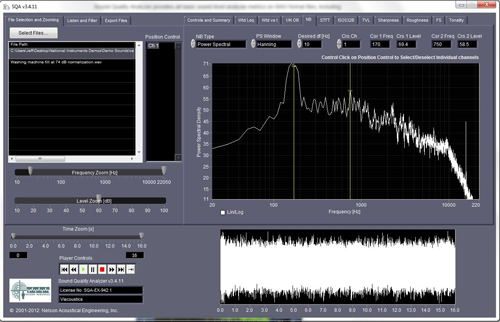
The Trident STFT Analyzer provides a powerful graphical display of the narrowband signal analysis vs time. The display can be very useful for identification of tones and modulations in the time waveform. It is also used in conjunction with the SQA filtering and listening tools to provide a visual guide for setting filters.

Sound Quality Analyzer provides tools for listening to your audio WAV files while you view the analysis.
Filtering tools allow you to isolate various frequency ranges and modify the WAV file for auralization of sound quality properties.
Sound Quality Analyzer provides an audio player that allows you to play your WAV files from your sound card while you view the signal processing analysis. Separate routing for two channel output allows listening to binaural recorded files.
Real time audio filtering used in conjunction with the STFT display allows users to perform the following filtering on their WAV files
- Low Pass/High Pass
- Band Pass/Band Stop
Filtered WAV files can then be saved for additional sound quality analysis.
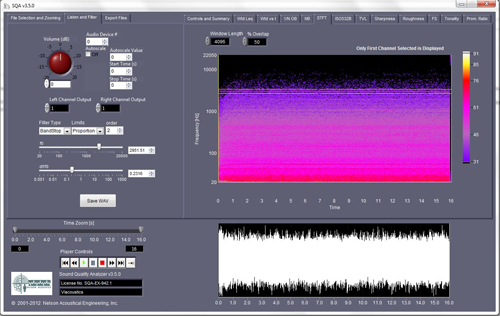
Sound Quality Analyzer provides several methods for achieving proper level calibration of WAV files, which is an inherently uncalibrated file format, but a convienient file format because there are so many ways to record and listen to WAV format files.
The easiest way to properly calibrate WAV files for use in Sound Quality Analyzer is to make your files using National Instruments hardware and our Trident data acquisition software. Trident embeds a “normalization” value into the header of the WAV file as it is being saved that Sound Quality Anlyzer can read when the file is retrieved for analysis. Level calibration is seamless using this method.
If you have generated your WAV files using another recording or data acquisition system, you can achieve level calibration on the file using one of these two methods
- A-weighted sound level calibration – If the overall A-weighted Leq sound pressure level of the WAV file recording is known, simply enter that sound pressure level into Sound Quality Analyzer when the file is retrieved and Sound Quality Analyzer will properly scale the file.
- Calibration Signal Recording – Record a WAV file with a tone or signal of a known level using the same recording input gain setting that were used to record the WAV file. Sound Quality Analyzer will use the calibration recording to generate the proper normalization term for the WAV file to be analyzed.
Sound Quality Analyzer provides a method for achieving level calibration of WAV files generated from most any recording device or data acquisition system, bringing the power of sound quality and psychoacoustic analysis to users without the high cost of the hardware normally associated with such analysis.
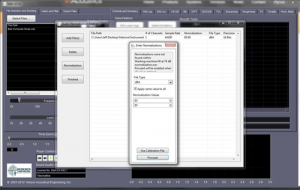
Sound Quality Analyzer conducts the following sound level analysis functions on audio WAV format files.
- Overall weighted sound pressure levels – A, B, C and Linear weightings
- Weighted sound pressure level vs time – A, B, C and Linear weightings; Fast/Slow/Custom Time Constants
Graphical time waveform and sound level vs time displays with cursor that allows users to read instantaneous sound pressure level versus time.
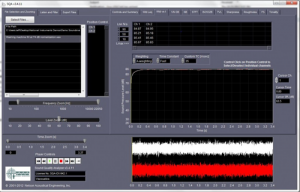
Sound Quality Analyzer conducts Fluctuation Strength Analysis on audio WAV files.
Fluctuation Strength (vacil) – A measure of the low frequency (<20Hz) modulation within a signal. When modulations are less than 20 Hz, the human ear can perceive the individual modulations as single events. The ear is most sensitive to these modulations at a frequency of around 4 Hz, so the sensitivity of the metric peaks at this modulation frequency. Values for Fluctuation Strength are typically less than 1 vacil and may be expressed in centivacils. Fluctuation Strength is not a standardized metric. The SQA uses the Höldrich method of determination of Fluctuation Strength.
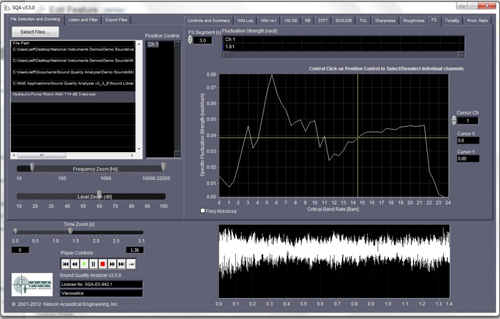
Sound Quality Analyzer conducts Roughness analysis on audio WAV files.
Roughness (asper) – A measure of the high frequency (>20 Hz) modulation within a signal. Fast modulations are often described as “warble” or “buzz” sounds. When modulations are faster than 20 Hz the ear can no longer perceive the modulations as individual events but can detect variations in the envelope of the sound. The ear is highly sensitive to modulations around 70 Hz, so the sensitivity of the metric peaks at this modulation frequency. Values for Roughness in are typically less than 1 asper and may be expressed in centiaspers. Roughness is not a standardized metric. The SQA uses the Aures method of determination of Roughness.
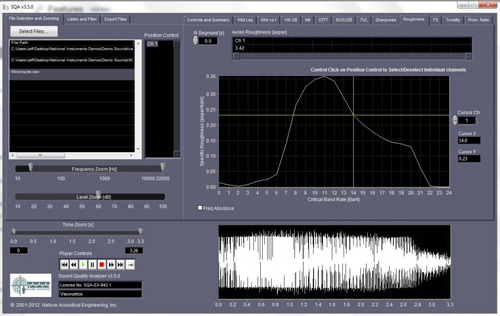
Sound Quality Analyzer conducts Sharpness analysis on audio WAV files.
Sharpness (acum) – A measure of the spectral balance of the sound between its low frequency content and it’s high frequency content. Sounds with too much high frequency compared to the low frequency content will tend to sound “sharp”. Sharpness is not a standardized metric. The SQA uses the Aures method of determination of Sharpness

Sound Quality Analyzer conducts psychoacoustic loudness analysis of audio WAV files.
Loudness (sones) – A measure of the perceived sensation of the volume of a sound. The loudness of the sound considers not only the level of the sound but the frequency composition of the sound. Broadband sounds will have a lower loudness than narrowband signals for a given level. Loudness in Sones is a linear quantity, meaning that a sound with a Loudness of 2 Sones is perceived as twice as loud as a sound with a Loudness of 1 Sone. Loudness has been standardized in the ISO 532B standard.

Sound Quality Analysis conducts Prominent Tone Analysis on audio WAV file recordings
Prominence Ratio (dB) – A standardized method for analyzing a sound for tones that will be judged as being “prominent” by most listeners to the sound. Prominence Ratio is similar to Tonality in that it compares the energy in tones within a sound to the broadband energy around tone, using a Fast Fourier Transform Analysis. Prominence Ratio has been standardized in international standards such as ISO 7779 and ECMA-74.
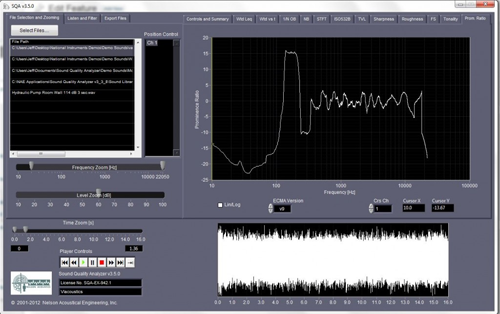
Sound Quality Analyzer conducts Tonality Analysis on audio WAV files
Tonality (tu) – A measure of the fraction of perceived loudness due to tones, considering hearing threshold and psychoacoustics loudness levels. Results are expressed as an overall mean tonality (in %) and T(N) levels, which is the Tonality exceeded N% of the time within a time varying sound. SQA uses the Aures method of determination of Tonality.
HMS Tonality (tuHMS) – Based on the Hearing Model developed by Roland Sottek of Head Acoustics, this method estimates the overall strength of tones rather than their fractional loudness. The method addresses hearing threshold and psychoacoustic loudness levels and provides a high degree of time-resolution to measure transient and rapidly changing tonalities. This method also differs from the Prominence Ratio method through its basis in a detailed perception model rather than relative energy measurement.
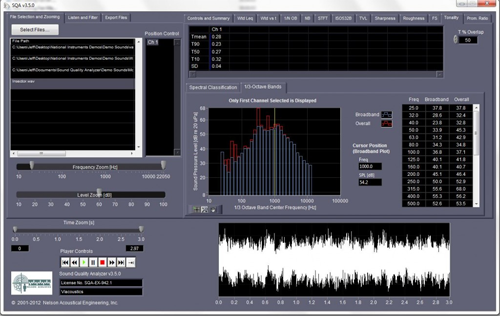
Sound Quality Analyzer conducts Modulation Analysis on audio WAV files
Modulation (%) – The degree of modulation is determined in each of 47 overlapping critical bands. Apparent modulations due to broadband noise are identified by their band-to-band correlation and suppressed. An overall modulation value is obtained by weighting the band results according to empirically determined psychoacoustic sensitivity functions considering level, carrier frequency, modulation frequency, and correlation, then summing them together. See Nelson “Filling the Modulation Gap” Noise Con 2014.
Pricing
The Sound Quality Analyzer sells for $7,500 USD.
